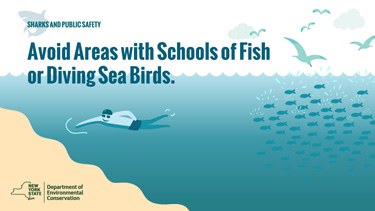 September 7, 2022 — Sharks already get a bad rap, but with all the recent news of an uptick in shark sightings along Long Island beaches, the East Coast, and around the world, many people are growing wary of entering the water.
September 7, 2022 — Sharks already get a bad rap, but with all the recent news of an uptick in shark sightings along Long Island beaches, the East Coast, and around the world, many people are growing wary of entering the water.
It might seem more dangerous given the media attention, but according to shark experts, negative shark interactions are still uncommon and increased shark activity is actually a good sign of a thriving ocean.
“Sharks are meant to be there,” said PEF member Christopher Scott, a marine biologist with the Department of Environmental Conservation’s Division of Marine Resources. “It’s a positive sign these animals are here, without them, the oceans would be less healthy. It’s important to the ecosystem and should be celebrated.”
According to the Atlantic States Marine Fisheries Commission’s (ASMFC) Coastal Shark Management Board, “Sharks are a vital part of ocean ecosystems all over the world. Scientists consider them to be a keystone species because they generally reside at the top of the food chain having a strong impact on other species either directly or indirectly. Removing or reducing shark populations in an area can cause an imbalance in the food chain and produce far reaching negative impacts.
Dealing with shark-human interactions
In his role at the DEC, Scott works closely with state parks staff, law enforcement and first responders to address incidents across Long Island beaches, advising them on how to prepare for and respond to shark activity and sightings.
“When there is an incident, we reach out to first responders and ask them specific questions about the environment — what bait is around, what were swimmers doing,” Scott said. “We use this information to determine the species and to inform public safety.”
If you are taking a trip to the shore, Scott said it is always best to err on the side of caution and be aware of your surroundings.
“Anyone entering a natural environment needs to respect that environment,” he said. “Humans assume the risk and there is always a chance of interacting with something. The best tool is to change your behavior and avoid certain things.”
“A lot of shark bites are due to misidentification by sharks,” he said. “They feed on small fish, so to minimize misidentification, don’t go where there are schools of bait fish and avoid areas with a lot of seal activity. Don’t go out during dusk or at night because those are times when sharks feed. Don’t go in murky water.”
Increasing shark awareness on the job
At the Division of Marine Resources, DEC staff dedicate much of their time to various interstate fisheries management plans, including for coastal sharks. Coastwide management of sharks in state waters is regulated by the ASMFC Coastal Shark Management Board.
“When the board makes recommendations, states have to create and implement regulations in accordance,” Scott said. “For example, when the population of shortfin mako took a nosedive, we had to implement regulations to shut down fisheries.”
Each year during Discover Channel’s “Shark Week,” DEC staff run a social media campaign to counter the stereotype that sharks are the stuff of nightmares and educate the public on these often-misunderstood creatures.
Throughout the year, staff also respond to reports of deceased sharks as part of the Shark Salvage Program, where dead sharks are retrieved to record information such as species, sex, and length, and document the carcass with pictures and its stranding location coordinates. The salvage program affords scientists the opportunity to retrieve samples and advance research on sharks.
 “We work with shark researchers to secure the animals and perform a necropsy,” he said. “We look for signs of why the animal died and can take tissue samples that you can only get with a deceased shark. This is a great way to advance shark science locally.”
“We work with shark researchers to secure the animals and perform a necropsy,” he said. “We look for signs of why the animal died and can take tissue samples that you can only get with a deceased shark. This is a great way to advance shark science locally.”
Some of the department’s research is facilitated by the public.
“We have the Shark Spotter program where the public can submit observations of sharks in the wild,” Scott said. “The information helps biologists record the presence of sharks and helps further the understanding of local shark ecology and behavior.”
You can take part in the program by submitting sightings here. You can also view sightings reported by others here.
For Scott, a lifetime passion for large marine life led him to the DEC.
“I’ve always had a passion for large fish like tuna and sharks,” he said. “Our unit, Marine Fisheries, handles everything from crabs and lobsters to sturgeon and sharks. A wide swath of things come our way.”
To learn more about sharks, visit the DEC’s shark webpage here.

